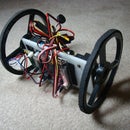Introduction: Experimental Robot Platform
The goal of this robot is to give me a platform that is upgradeable and customizable so that I would not need to build a new robot chassis for each new idea I want to try out. I have been working on this robot off and on for almost a year now.
I want it capable of entering many different types of robot contests, from Trinity to MOBOT and others. It is being designed to do *everything* like a robot really should. My philosophy says a robot designed to be good at only one task is no better than a dishwasher =P
As a side note, I am keeping a journal documenting more of the specific details. Feel free to check it out if you aren't satisfied with the summarized info I put in this instructable:
http://www.societyofrobots.com/robot_ERP.shtml
Step 1: The Mechanical Design
This is an early concept CAD rendering of it that I made:
I used FEA software to design both the robot arm (see image) and the suspension system. The robot arms consist of multiple servos, and one of them has a controllable gripper. I custom machined all parts using a CNC out of delrin.
I made a video documenting on how I made the suspension system. What makes this suspension system new and unique is that its made from just one single easy to manufacture part!
To give good friction to the custom wheels, I rolled up some sticky rubber and bandsaw'ed a long strip of it. It then went right around the wheel (see images).
The final design is the last image.
This is a video of my robot arm testing below. The robot is drivin by two servos.
Step 2: The Electronics
There was no good microcontroller on the market that can handle all the features I needed.
So using Eagle CAD software I custom designed my own microcontroller, which I call the Axon. It is 100% RoHS compliant, as is the rest of the robot (meaning, lead free and environmentally safe).
It has tons of features, like 16 ADC, 4 UARTs, USB, a bootloader, 55+ I/O, 16MHz, 64kb of flash, and 8kb of RAM.
To mount it, I first screwed on some spacers (see first image). Then I put it on the ERP and attached all the sensor and servo wires (second image).
Step 3: The Sensors
The main sensor is the Blackfin Robot Camera which I connected up to my Axon microcontroller.
Below the camera I attached a simple Sharp IR rangefinder to measure distances of whatever the camera can see.
I then programmed it to use its head to track a white line and entered it into the CMU MOBOT contest:
Step 4: Adding Personality
Check out the images for a better idea of what I mean . . .
And nothing says 'personality' more than ninja skills!
Step 5: Robot Vision
By using middle mass detection, the ERP can track colors and even fire!
Step 6: Vote for This Robot!
If you've felt entertained or educated by my hard work, please vote for this instructable on the contest page!
If you have any questions on how to build this robot or others, feel free to ask any questions you like. I'd be happy to help.
thanks for reading! =)
Grand Prize in the
Instructables and RoboGames Robot Contest
Participated in the
The Instructables Book Contest













